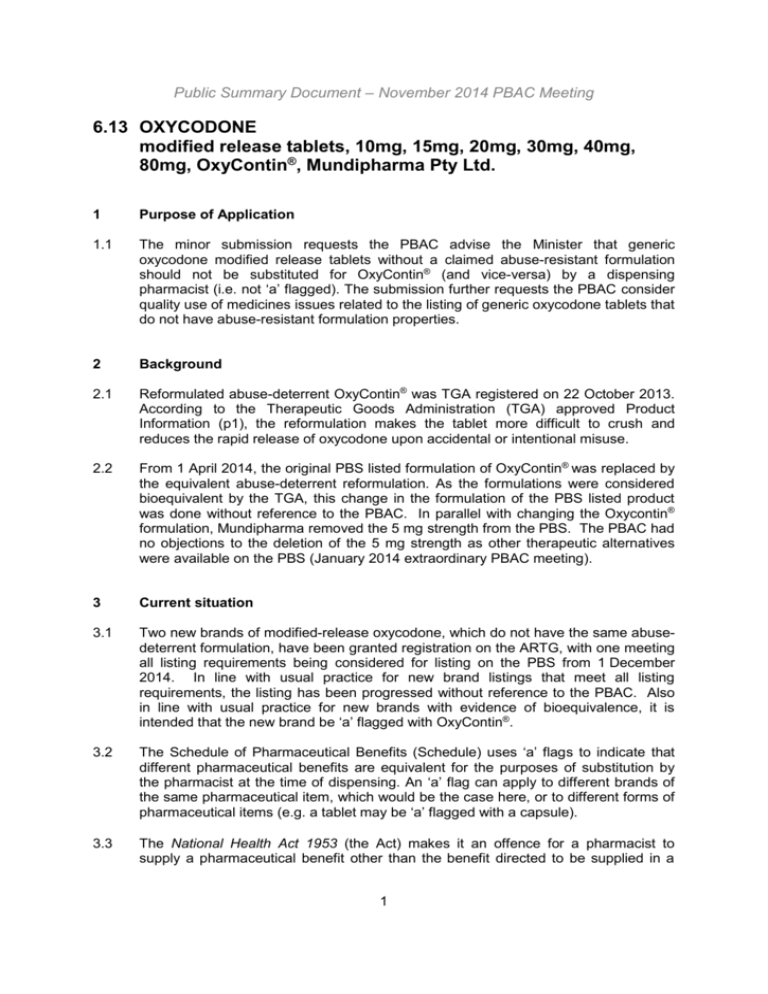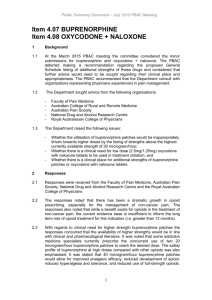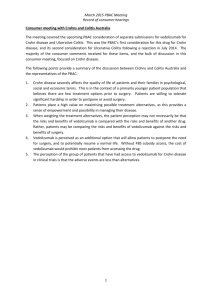(PSD) November 2014 PBAC Meeting
advertisement

Public Summary Document – November 2014 PBAC Meeting 6.13 OXYCODONE modified release tablets, 10mg, 15mg, 20mg, 30mg, 40mg, 80mg, OxyContin®, Mundipharma Pty Ltd. 1 Purpose of Application 1.1 The minor submission requests the PBAC advise the Minister that generic oxycodone modified release tablets without a claimed abuse-resistant formulation should not be substituted for OxyContin® (and vice-versa) by a dispensing pharmacist (i.e. not ‘a’ flagged). The submission further requests the PBAC consider quality use of medicines issues related to the listing of generic oxycodone tablets that do not have abuse-resistant formulation properties. 2 Background 2.1 Reformulated abuse-deterrent OxyContin® was TGA registered on 22 October 2013. According to the Therapeutic Goods Administration (TGA) approved Product Information (p1), the reformulation makes the tablet more difficult to crush and reduces the rapid release of oxycodone upon accidental or intentional misuse. 2.2 From 1 April 2014, the original PBS listed formulation of OxyContin® was replaced by the equivalent abuse-deterrent reformulation. As the formulations were considered bioequivalent by the TGA, this change in the formulation of the PBS listed product was done without reference to the PBAC. In parallel with changing the Oxycontin® formulation, Mundipharma removed the 5 mg strength from the PBS. The PBAC had no objections to the deletion of the 5 mg strength as other therapeutic alternatives were available on the PBS (January 2014 extraordinary PBAC meeting). 3 Current situation 3.1 Two new brands of modified-release oxycodone, which do not have the same abusedeterrent formulation, have been granted registration on the ARTG, with one meeting all listing requirements being considered for listing on the PBS from 1 December 2014. In line with usual practice for new brand listings that meet all listing requirements, the listing has been progressed without reference to the PBAC. Also in line with usual practice for new brands with evidence of bioequivalence, it is intended that the new brand be ‘a’ flagged with OxyContin®. 3.2 The Schedule of Pharmaceutical Benefits (Schedule) uses ‘a’ flags to indicate that different pharmaceutical benefits are equivalent for the purposes of substitution by the pharmacist at the time of dispensing. An ‘a’ flag can apply to different brands of the same pharmaceutical item, which would be the case here, or to different forms of pharmaceutical items (e.g. a tablet may be ‘a’ flagged with a capsule). 3.3 The National Health Act 1953 (the Act) makes it an offence for a pharmacist to supply a pharmaceutical benefit other than the benefit directed to be supplied in a 1 Public Summary Document – November 2014 PBAC Meeting prescription except when, amongst other criteria, the Schedule issued by the Department of Health states that the specified benefit and the substitute benefit are equivalent. The relevant section of the Act is reproduced below. Extract from National Health Act 1953 s103 Offences … (2) Except as prescribed, a pharmacist to whom a prescription is presented shall not: (a) supply, in purported pursuance of this Part, anything other than the pharmaceutical benefit that is directed to be supplied in the prescription; or (b) in exchange for the prescription make a payment in money or give any other consideration to the person presenting the prescription. Penalty: $2,000 or imprisonment for 12 months, or both. (2A) Paragraph (2)(a) does not prohibit a pharmacist from supplying, instead of the pharmaceutical benefit that is directed to be supplied in a prescription (the specified benefit), another pharmaceutical benefit (the substitute benefit) if: (a) the person who prescribed the specified benefit did not indicate on the prescription that only that benefit was to be supplied; and (b) the Schedule of Pharmaceutical Benefits issued by the Department states that the specified benefit and the substitute benefit are equivalent; and (c) the substitute benefit is a listed brand of a pharmaceutical item; and (d) the supply of the substitute benefit is not prohibited by a law of the State or Territory in which the substitute benefit is supplied. 3.4 When writing a prescription, prescribers are able to indicate whether or not they wish to allow the prescribed item to be substituted with an equivalent item at the time of dispensing by the pharmacist. Pharmacists are not permitted to substitute items on prescriptions where the prescriber has marked “brand substitution not permitted”, “not for substitution” or other words to that effect. If a prescriber was concerned by the way their patient may use the medication, marking a prescription as not suitable for substitution is an option available to all prescribers to ensure the patient receives the preferred formulation. 3.5 A pharmacist is not obliged to substitute brands at the time of dispensing. If a pharmacist had concerns about the way the patient would use the medication, the pharmacist could elect not to substitute brands. 3.6 Any significant safety concerns regarding generic formulations of oxycodone modified release would normally be addressed by the TGA. Under the Therapeutic Goods Act 1989, the Secretary can remove approved medicines from the ARTG on grounds including where failure to cancel the product would result in an imminent risk of death, serious illness or serious injury, or where it appears to the Secretary that the safety, quality or efficacy of the product is unacceptable. Given that the TGA granted original approval for the generic products on the basis that the safety, quality and efficacy was satisfactorily established, the delegate would have to be satisfied that the risk-benefit balance has changed sufficiently to warrant such action. 2 Public Summary Document – November 2014 PBAC Meeting 3.7 Abuse-deterrent OxyContin® is not recommended for patients with swallowing difficulties, patients with mechanical bowel obstruction, and patients prone to intestinal obstruction because of conditions such as bowel cancer or excessive bowel inflammation and swelling due to Crohn’s disease. The availability of a generic brand of oxycodone, without abuse-deterrent properties, would provide an alternative treatment option for these patients. 3.8 There is some evidence emerging from overseas, and reported in the medical literature, which indicates that while the release of Mundipharma’s abuse-deterrent OxyContin® formulation has been associated with a reduction in injuries or deaths from oxycodone, there has been a rise in the abuse of other opioid medications, such as fentanyl and heroin. 3.9 The PBAC were advised that at the Senate Estimates Hearing on Community Affairs Legislation Committee on 2 June 2014, it was reported that the Sydney Medically Supervised Injecting Centre has advised that injecting drug users in Australia are now successfully injecting the abuse-deterrent formulation. 3.10 The submission suggests that if non-abuse deterrent formulations of oxycodone are to be introduced onto the PBS then the Schedule should clearly differentiate between abuse-deterrent and non-abuse-deterrent formulations to avoid confusion by health care providers. The Department advised that the following note will be included in the PBS schedule to make the difference in the formulations clear to assist prescribers to prescribe the most suitable product to meet the clinical needs of their patients: Note OxyContin modified release tablets are intended to be crushdeterrent and to reduce the rapid release of oxycodone upon accidental or intentional misuse. 4 Clinical claim 4.1 As this is a minor submission, no claim of superiority in relation to comparative harms of the abuse-deterrent formulation compared to the generic formulations has been assessed. 5 PBAC consideration of the evidence Sponsor hearing 5.1 There was no hearing for this item as it was a minor submission. Consumer comments 3 Public Summary Document – November 2014 PBAC Meeting 5.2 The PBAC noted and welcomed the input from individuals (3), health care professionals (3) and organisations (7) via the Consumer Comments facility on the PBS website. 5.3 The majority of the comments received described a range of potential harms in relation to treatment with non-abuse deterrent oxycodone including increased diversion and abuse, compromising patient care and safety while also placing pharmacists at risk in the workplace. These comments were received from the Pharmaceutical Society of Australia, Australian Pain Society, Society of Hospital Pharmacists of Australia, and the Australian and New Zealand College of Anaesthetists. It was stated by these organisations that the risks of listing non-abuse deterrent formulations far outweighs any potential benefits, with this listing being irresponsible, costly and damaging to the community. Comments further highlighted that abuse deterrent formulations align with the National Pain Strategy (2010), the National Pharmaceutical Drug Misuse Framework for Action (2014), the Prescription Opioid Policy and the Drug Misuse Framework which promote the use of tamperresistant technologies. 5.4 In contrast, other comments were received from Alphapharm and Sandoz which stated that prohibiting ‘a’ flagging threatens patient choice and timely access to affordable medication, while also removing the ability for pharmacists to exercise professional judgement. For more detail on PBAC’s view, see section 6 “PBAC outcome” 6 PBAC Outcome 6.1 The PBAC did not agree to the submission’s request that PBAC advise the Minister that generic oxycodone modified release tablets without abuse-resistant formulations should not be ‘a’ flagged with OxyContin. 6.2 The PBAC noted that it is usual practice for brands of the same pharmaceutical item which have been considered by the TGA to be bioequivalent to be ‘a’ flagged in the Schedule. 6.3 The PBAC further noted that based on the TGA’s finding of bioequivalence, it is reasonable to conclude that the two modified release oxycodone products would be therapeutically equivalent when taken as intended, and that therapeutic equivalence is the primary consideration for ‘a’ flagging. 6.4 The PBAC noted the Department’s advice that a note will be included in the PBS schedule that makes the difference in the formulations clear and agreed this would assist prescribers to choose the most suitable product to meet the clinical needs of their patients. 6.5 The PBAC also noted input via the Consumer Comments facility on the PBS website and recognised the concerns raised regarding Quality Use of Medicines. 4 Public Summary Document – November 2014 PBAC Meeting 6.6 Whilst acknowledging these concerns highlighted in the consumer comments and noting that abuse deterrent formulations may have some impact on QUM, the PBAC considered that removing ‘a’ flagging between OxyContin and other brands was not an appropriate mechanism to deal with abuse, which it is part of a much broader problem of opioid overuse. 6.7 In this context, the PBAC noted that use of opioids, particularly oxycodone and paracetamol + codeine, is drastically increasing. The PBAC advised the Minister that a systematic approach should be undertaken to review and target the use of these opioids to promote the Quality Use of Medicines. 6.8 Lastly, the PBAC noted advice from the Department that the Electronic Recording and Reporting of Controlled Drugs (ERRCD) initiative may improve the ability to efficiently monitor the prescribing and dispensing of Controlled Drugs, including oxycodone, to help ensure appropriate access to these medicines and in turn address consumer concerns. 6.9 The PBAC noted that this submission is not eligible for an Independent Review. This process is not available in response to a request from the Minister’s delegate for PBAC advice in relation to ‘a’ flagging. Outcome: The PBAC advises the Minister that generic oxycodone modified release tablets without a claimed abuse-resistant formulation should be schedule equivalent to oxycodone, modified release tablets, 10mg, 20mg, 30mg, 40mg and 80mg with the brand OxyContin, for the purposes of the Schedule of Pharmaceutical Benefits referred to in paragraph 103(2A)(b) of the National Health Act 1953 (“the Act”). 7 Context for Decision The PBAC helps decide whether and, if so, how medicines should be subsidised in Australia. It considers submissions in this context. A PBAC decision not to recommend listing or not to recommend changing a listing does not represent a final PBAC view about the merits of the medicine. A company can resubmit to the PBAC or seek independent review of the PBAC decision. 8 Sponsor’s Comment Mundipharma is disappointed that the PBAC has limited its consideration of substitutability to the criterion of bioequivalence, when it is not obliged to do so. If the objective of the PBAC is to assist prescribers to choose the most suitable product to meet the clinical needs of individual patients then a more prudent option would be to allow both products to be available on the PBS, but not to recommend an ‘a’ flag. This would ensure both that the prescribers have choice and that what gets dispensed matches their prescribing intention. It would also provide better protection to dispensing pharmacists. Mundipharma agrees that the problem of prescription opioid abuse requires a broad approach. No single initiative, however, can be 5 Public Summary Document – November 2014 PBAC Meeting expected to solve the problem in isolation. The National Prescription Opioids Abuse Framework for action, which has been ratified by the Commonwealth Government, includes a specific recommendation to ‘promote the use of tamper-resistant technologies for target medications’. Mundipharma believes that this recommendation represents a missed opportunity to support an important element of the Framework. 6





